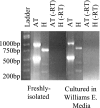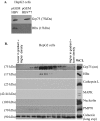Hepatitis B virus HBx protein localizes to mitochondria in primary rat hepatocytes and modulates mitochondrial membrane potential
- PMID: 18448529
- PMCID: PMC2446973
- DOI: 10.1128/JVI.00154-08
Hepatitis B virus HBx protein localizes to mitochondria in primary rat hepatocytes and modulates mitochondrial membrane potential
Abstract
Over 350 million people are chronically infected with hepatitis B virus (HBV), and a significant number of chronically infected individuals develop primary liver cancer. HBV encodes seven viral proteins, including the nonstructural X (HBx) protein. The results of studies with immortalized or transformed cells and with HBx-transgenic mice demonstrated that HBx can interact with mitochondria. However, no studies with normal hepatocytes have characterized the precise mitochondrial localization of HBx or the effect of HBx on mitochondrial physiology. We have used cultured primary rat hepatocytes as a model system to characterize the mitochondrial localization of HBx and the effect of HBx expression on mitochondrial physiology. We now show that a fraction of HBx colocalizes with density-gradient-purified mitochondria and associates with the outer mitochondrial membrane. We also demonstrate that HBx regulates mitochondrial membrane potential in hepatocytes and that this function of HBx varies depending on the status of NF-kappaB activity. In primary rat hepatocytes, HBx activation of NF-kappaB prevented mitochondrial membrane depolarization; however, when NF-kappaB activity was inhibited, HBx induced membrane depolarization through modulation of the mitochondrial permeability transition pore. Collectively, these results define potential pathways through which HBx may act in order to modulate mitochondrial physiology, thereby altering many cellular activities and ultimately contributing to the development of HBV-associated liver cancer.
Figures









Similar articles
-
Hepatitis B virus X protein modulates apoptosis in primary rat hepatocytes by regulating both NF-kappaB and the mitochondrial permeability transition pore.J Virol. 2009 May;83(10):4718-31. doi: 10.1128/JVI.02590-08. Epub 2009 Mar 11. J Virol. 2009. PMID: 19279112 Free PMC article.
-
Replication of the hepatitis B virus requires a calcium-dependent HBx-induced G1 phase arrest of hepatocytes.Virology. 2010 Nov 10;407(1):14-25. doi: 10.1016/j.virol.2010.07.042. Epub 2010 Aug 16. Virology. 2010. PMID: 20719353 Free PMC article.
-
A direct role for hepatitis B virus X protein in inducing mitochondrial membrane permeabilization.J Viral Hepat. 2018 Apr;25(4):412-420. doi: 10.1111/jvh.12831. Epub 2018 Jan 24. J Viral Hepat. 2018. PMID: 29193612 Free PMC article.
-
The hepatitis B virus HBx protein modulates cell cycle regulatory proteins in cultured primary human hepatocytes.Virus Res. 2011 Jan;155(1):363-7. doi: 10.1016/j.virusres.2010.09.023. Epub 2010 Oct 8. Virus Res. 2011. PMID: 20934470 Free PMC article.
-
The Epigenetic Modulation of Cancer and Immune Pathways in Hepatitis B Virus-Associated Hepatocellular Carcinoma: The Influence of HBx and miRNA Dysregulation.Front Immunol. 2021 Apr 29;12:661204. doi: 10.3389/fimmu.2021.661204. eCollection 2021. Front Immunol. 2021. PMID: 33995383 Free PMC article. Review.
Cited by
-
Hepatitis B Virus X Protein Induces Reactive Oxygen Species Generation via Activation of p53 in Human Hepatoma Cells.Biomolecules. 2024 Sep 24;14(10):1201. doi: 10.3390/biom14101201. Biomolecules. 2024. PMID: 39456134 Free PMC article.
-
The hepatitis B virus X protein elevates cytosolic calcium signals by modulating mitochondrial calcium uptake.J Virol. 2012 Jan;86(1):313-27. doi: 10.1128/JVI.06442-11. Epub 2011 Oct 26. J Virol. 2012. PMID: 22031934 Free PMC article.
-
Luteolin-7-O-Glucoside Present in Lettuce Extracts Inhibits Hepatitis B Surface Antigen Production and Viral Replication by Human Hepatoma Cells in Vitro.Front Microbiol. 2017 Dec 6;8:2425. doi: 10.3389/fmicb.2017.02425. eCollection 2017. Front Microbiol. 2017. PMID: 29270164 Free PMC article.
-
Effect of HBx on inflammation and mitochondrial oxidative stress in mouse hepatocytes.Oncol Lett. 2020 Apr;19(4):2861-2869. doi: 10.3892/ol.2020.11404. Epub 2020 Feb 17. Oncol Lett. 2020. PMID: 32218840 Free PMC article.
-
Hepatitis B Virus Precore Protein p22 Inhibits Alpha Interferon Signaling by Blocking STAT Nuclear Translocation.J Virol. 2019 Jun 14;93(13):e00196-19. doi: 10.1128/JVI.00196-19. Print 2019 Jul 1. J Virol. 2019. PMID: 31019054 Free PMC article.
References
-
- Andrisani, O., and S. Barnabas. 1999. The transcriptional function of the hepatitis B virus X protein and its role in hepatocarcinogenesis. Int. J. Oncol. 151-8. - PubMed
-
- Anflous, K., O. Blondel, A. Bernart, M. Khrestchatisky, and R. Ventura-Clapier. 1998. Characterization of rat porin isoforms: cloning of a cardiac type-3 variant encoding an additional methionine at its putative N-terminal region. Biochim. Biophys. Acta 139947-50. - PubMed
-
- Beasley, R., C.-C. Lin, L.-Y. Hwang, and C.-S. Chien. 1981. Hepatocellular carcinoma and hepatitis B virus: a prospective study of 22 707 men in Taiwan. Lancet ii1129-1133. - PubMed
-
- Bernardi, P. 1999. Mitochondrial transport and cations: channels, exchangers, and permeability transition. Physiol. Rev. 791127-1155. - PubMed
Publication types
MeSH terms
Substances
Grants and funding
LinkOut - more resources
Full Text Sources
Other Literature Sources

